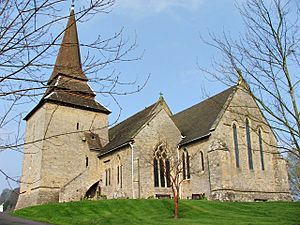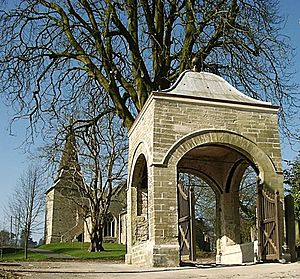Church of St Mary, Kington facts for kids
Quick facts for kids Church of St Mary |
|
|---|---|
| St. Mary the Virgin Church | |

The church in April 2005
|
|
| 52°12′16″N 3°02′18″W / 52.2045°N 3.03839°W | |
| OS grid reference | SO2913556762 |
| Location | Church Road, Kington, Herefordshire |
| Country | England |
| Denomination | Church of England |
| History | |
| Status | Parish church |
| Architecture | |
| Functional status | Active |
| Heritage designation | Grade I listed |
| Designated | October 1953 |
| Years built | c. 1300 |
| Specifications | |
| Bells | 6 (1736-1764) |
| Tenor bell weight | 11 long cwt 23 lb (1,255 lb or 569 kg) |
| Administration | |
| Diocese | Hereford |
The Church of St Mary in Kington, Herefordshire, England, is a very old and important church. It is also known as St. Mary the Virgin Church. It is a parish church, which means it serves the local community. This church is so special that it has a "Grade I listed" status. This means it is a building of exceptional historical interest and is protected by law.
The church was first built around the year 1300. However, it has been changed and added to many times over the centuries. It has a tower that dates back to the 12th century, which is even older than the main church building! This tower was originally separate but was later connected to the church when it was made bigger in the 13th century.
Contents
Church Features
The Tower and Bells
The church tower is a very old part of the building. In the 18th century, a special kind of pointed roof called a "double broach spire" was added to the top of the tower. Inside the tower, there are six large bells. These bells are part of a "ring," which means they are designed to be rung together in a specific sequence to create music.
Five of these bells were made by a famous bell-making company called Rudhall of Gloucester between 1736 and 1739. The largest bell, called the "tenor bell," is very heavy, weighing over 11 tons! It rings in the musical note of F-sharp. The sixth bell was made by William Evans of Chepstow in 1764. All the bells were repaired and made new again in 1978 by another well-known company, the Whitechapel Bell Foundry.
The Organ
The Church of St Mary also has a beautiful organ. This musical instrument was built by J. W. Walker & Sons Ltd. It was placed in the north part of the church, near the altar, in 1883. Later, in 1959, it was improved and refurbished by Henry Willis & Sons, another famous organ builder.
The Lychgate
At the entrance to the churchyard, you will find a special gate called a "lychgate." This lychgate is made from carefully carved stone and dates back to the 18th century. It is also a very important historical structure and has its own "Grade II* listing." This means it is a particularly important building of more than special interest.
The design of this lychgate is quite unusual. It has a rounded, dome-shaped roof with a decorative top piece called a "finial." There are open archways built into each of its walls, making it look very grand.
Inside the Church
When you go inside the church, you can see a special monument made of "alabaster." Alabaster is a soft, white stone often used for carvings. This monument honors Sir Thomas Vaughan, who passed away in 1469 during a battle called the Battle of Edgecote Moor. It also honors his wife, Elen Gethin.
Church Status and Location
The Church of St Mary was officially given its "Grade I listed" status in October 1953. This legal protection helps make sure the church is not changed or torn down without permission. The church is part of the Diocese of Hereford, which is a large area managed by the Church of England. It is one of five churches, three in England and two in Wales, that are managed together as the "Kington Parishes."
Nearby Places
Right across from the church, you can see the original building of Lady Hawkins' School. This building was built in the 17th century. Today, it is no longer a school but is used as a private home.


